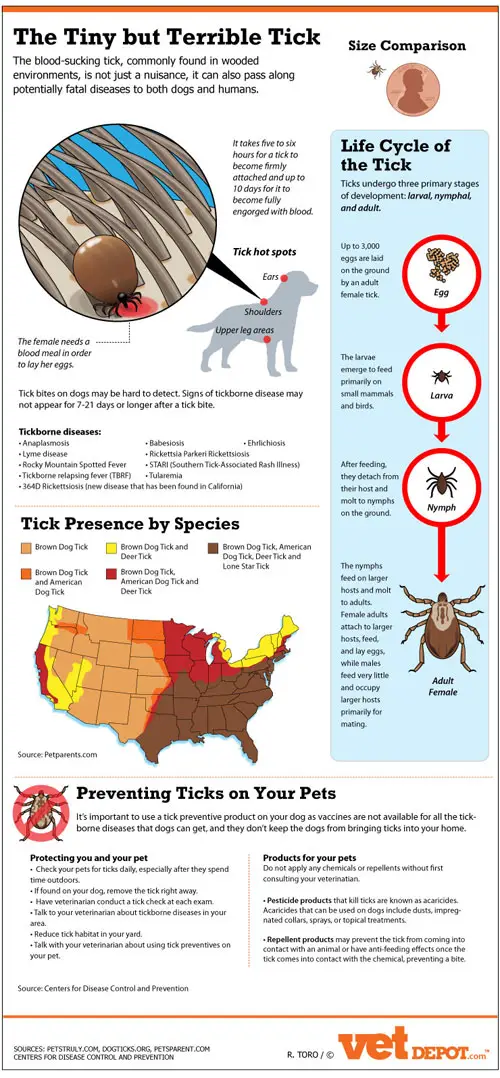Tick Control on Your German Shepherd
Tick control on your dog is an on-going two-step process. You have to treat both the environment and the pet. Overall, keep in mind that ticks are not that hard to kill. All outside pets are potential hosts for hungry ticks.
The best tips to keep ticks off your pets (and you as well) and to reduce their exposure to ticks overall are as follows - keep your dog out of tall grasses and heavily wooded areas.
Types of tick control products for dogs run the gamut from once-a-month topical products, to sprays, dips, shampoos, powders and collars.
Once-a-month topical insecticides are very popular (and are the easiest products to use, and also generally last the longest). These are applied to a small area down the back of the dog.
Some kill fleas and ticks, and others just fleas, so read the label very carefully. Examples of these products include: Bio Spot for Dogs, Defend, K9 Advantix for Dogs, and Frontline Top Spot. Revolution (which contains selamectin) only controls American Dog Ticks.
Powders: Powders containing pyrethrin are easy to apply but are also quite messy. Be careful to use tick control powders in well-ventilated areas. If you or your pet has asthma, powders may not be the best choice of product since the powder could easily be inhaled. Powders are also available for your carpets and upholstery.

Shampoos: Shampoos containing pyrethrin are helpful in getting rid of the ticks the dog already has on it. To properly use a flea & tick shampoo you must be sure to work the shampoo in over the entire body and then leave it on at least 10 minutes before you rinse it off. Remember, protect the eyes and ears of the dog when using medicated shampoos.
Sprays: Flea and tick sprays often contain permethrin or pyrethrin and can come in aerosols or pump bottle form. Be careful when using sprays and do not get any of these products in the eyes of the dog. You do not have to soak the dog with the spray, but be sure to spray all parts of the dog. Spray a small amount on a paper towel or rag to apply the product around the dogs eyes and ears. Follow the manufacturer's instructions on how often to apply the tick control spray, and always use the spray in a well-ventilated area.
Dips: Dips and rinses may contain permethrin, pyrethrin, or organophosphates and should be applied in a well-ventilated area. Apply the dip to the entire animal. Dips generally have some residual activity as well. It is also a good idea to put cotton balls in the pet's ears and ophthalmic ointment in the pet's eyes just in case any dip enters these sensitive areas. Even with all these precautions, be very careful not to get any of the dip in the dogs ears or eyes.
Collars:Collars can be effective, but must be applied properly. Make sure that you watch carefully for any irritation that may occur underneath the collar area. If irritation occurs, you will need to use a different kind of product. Be sure to cut off any excess portion of the collar after you have put it on your dog. Check the flea/tick collar package for information the collar in the event they may get wet, etc. Sometimes collars (ex. Adams Flea and Tick Collar) contain ingredients such as carbamates and pyrethroids.
More Tick Control Products
In severely tick-infested areas or for dogs who spend a lot of time outdoors and in the woods, a Preventic Tick Collar plus a permethrin-containing product such as Bio Spot is going to give your dog the best 2 pronged protection.
Remember, no matter which tick preventive you decide to use on your pet, the ticks must actually be in contact with the active ingredient to be killed by it. Contact with the insecticide has to happen for the tick to take in the insecticide and die.
Tick prevention and tick control greatly reduces the risk of tick-transmitted diseases since it generally requires more than 24 hours of attachment for disease to be transmitted.
Even a dog who is treated with an insecticide could possibly get bitten by a tick that attaches for a long enough time to transmit disease. Vaccines for Lyme disease for dogs are also available to provide that extra protection.
With the correct tick prevention methods, however, these vaccines for Lyme disease may never be needed by your dog and you'll both be tick free. As always, contact your veterinarian with any questions you may have about ticks or tick control.

Return from Tick Control to Flea Products
"...Pomeranians speak only to Poodles and Poodles speak only to God." - Charles Kuralt on "48 Hours"
Sign up for promotions, news, discounts, and the chance to win prizes for you and your German Shepherd
